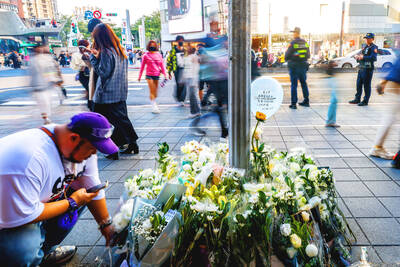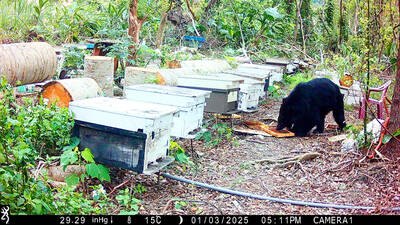Taiwan and China have found a model for peaceful coexistence — namely, the so-called “1992 consensus,” or “one China, different interpretations,” President Ma Ying-jeou (馬英九) said on two separate occasions in Boston on Saturday.
Addressing a banquet in honor of Taiwanese expatriates in the US, Ma said that the concept of the “1992 consensus” was proposed by Taiwan and accepted by China.
Some people have described the policy as a “masterpiece of ambiguity,” he said.

Photo: CNA
Regardless of whether it is ambiguous, the consensus has helped the two sides of the Taiwan Strait set aside their sovereignty disputes and pool their efforts for mutual benefit, Ma said.
The “1992 consensus” — a term former Mainland Affairs Council chairman Su Chi (蘇起) admitted making up in 2000 — refers to a tacit understanding between the Chinese Nationalist Party (KMT) and the Chinese government that both sides acknowledge there is “one China,” with each side having its own interpretation of what “China” means.
To promote peace, Ma said that since he took office, he has been promoting cross-strait relations, and trade and tourism exchanges have reached their highest point in 66 years.
Exchanges between the two sides are helpful for both sides, the president said, adding that he hopes they can continue exchanges and interactions based on the principle of the “1992 consensus.”
During the banquet, Ma also thanked the Massachusetts State House for its concern over burns victims from the June 27 explosion and fire at the Formosa Fun Coast water park in New Taipei City.
Ma also spoke at a seminar at Harvard University, with students, teachers, as well as US academics familiar with Taiwanese affairs attending.
The president reiterated his administration’s commitment to the “status quo,” his “three noes” policy of “no unification, no independence and no use of force,” and peaceful and prosperous cross-strait relations based on the Republic of China’s Constitution and the “1992 consensus.”
Up to 80 percent of the Taiwanese public supports maintaining the “status quo,” an indication that they hope to maintain peaceful and prosperous cross-strait relations created by his administration over the past seven years, Ma was reported as saying.
New York University School of Law professor Jerome Cohen reportedly proposed that Ma be nominated for the Nobel Peace Prize for his initiatives to resolve disputes in the East and South China seas.
Cohen made his proposal during the question-and-answer session after Ma’s speech, saying that he expects Ma to provide more proactive measures to promote peace on Itu Aba (Taiping Island, 太平島) in the South China Sea, according to a person who attended the seminar.
Itu Aba is the biggest Taiwan-controlled island in the contested and resource-rich South China Sea region, which is claimed either entirely or in part by Taiwan, Brunei, China, Malaysia, Vietnam and the Philippines.
Ma touted the benefits of a fisheries’ agreement signed in 2013 between Taiwan and Japan to address fishing disputes in waters surrounding the disputed Diaoyutai Islands (釣魚台) after his East China Sea peace initiative — which calls for shelving disputes and seeking joint development of resources — was proposed.
Ma said his proposal was based on the idea that “while national sovereignty cannot be divided or compromised, natural resources can be shared,” according to the attendee.
Ma arrived in Boston earlier that day en route to the Caribbean and Central America as part of his 11th overseas visit since assuming office in 2008.

SHIPS, TRAINS AND AUTOMOBILES: The ministry has announced changes to varied transportation industries taking effect soon, with a number of effects for passengers Beginning next month, the post office is canceling signature upon delivery and written inquiry services for international registered small packets in accordance with the new policy of the Universal Postal Union, the Ministry of Transportation and Communications said yesterday. The new policy does not apply to packets that are to be delivered to China, the ministry said. Senders of international registered small packets would receive a NT$10 rebate on postage if the packets are sent from Jan. 1 to March 31, it added. The ministry said that three other policies are also scheduled to take effect next month. International cruise ship operators

HORROR STORIES: One victim recounted not realizing they had been stabbed and seeing people bleeding, while another recalled breaking down in tears after fleeing A man on Friday died after he tried to fight the knife-wielding suspect who went on a stabbing spree near two of Taipei’s busiest metro stations, Taipei Mayor Chiang Wan-an (蔣萬安) said. The 57-year-old man, identified by his family name, Yu (余), encountered the suspect at Exit M7 of Taipei Main Station and immediately tried to stop him, but was fatally wounded and later died, Chiang said, calling the incident “heartbreaking.” Yu’s family would receive at least NT$5 million (US$158,584) in compensation through the Taipei Rapid Transit Corp’s (TRTC) insurance coverage, he said after convening an emergency security response meeting yesterday morning. National

The Forestry and Nature Conservation Agency yesterday launched a gift box to market honey “certified by a Formosan black bear” in appreciation of a beekeeper’s amicable interaction with a honey-thieving bear. Beekeeper Chih Ming-chen (池明鎮) in January inspected his bee farm in Hualien County’s Jhuosi Township (卓溪) and found that more than 20 beehives had been destroyed and many hives were eaten, with bear droppings and paw prints near the destroyed hives, the agency said. Chih returned to the farm to move the remaining beehives away that evening when he encountered a Formosan black bear only 20m away, the agency said. The bear

PLANNED: The suspect visited the crime scene before the killings, seeking information on how to access the roof, and had extensively researched a 2014 stabbing incident The suspect in a stabbing attack that killed three people and injured 11 in Taipei on Friday had planned the assault and set fires at other locations earlier in the day, law enforcement officials said yesterday. National Police Agency (NPA) Director-General Chang Jung-hsin (張榮興) said the suspect, a 27-year-old man named Chang Wen (張文), began the attacks at 3:40pm, first setting off smoke bombs on a road, damaging cars and motorbikes. Earlier, Chang Wen set fire to a rental room where he was staying on Gongyuan Road in Zhongzheng District (中正), Chang Jung-hsin said. The suspect later threw smoke grenades near two exits